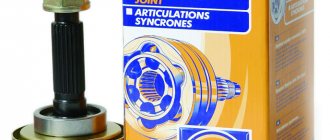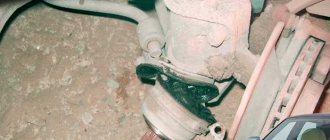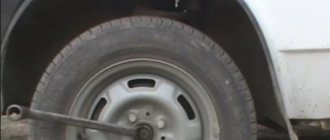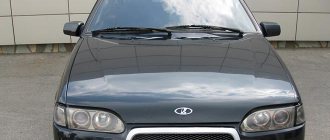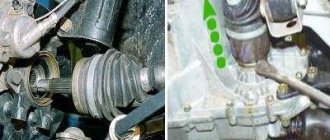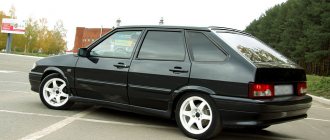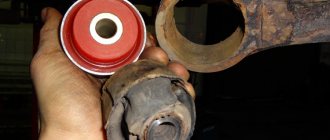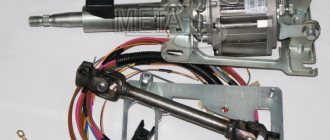How to remove an internal grenade?
In the first case, you simply remove the outer part of the CV joint from the shaft, then the retaining ring from the drive shaft and knock off the cage with a hammer. In the second case, removing the CV joint becomes more difficult. You need to deflect the grenade relative to the shaft at the maximum angle so that the bearing balls and their cage are visible.
Interesting materials:
How to make a non-breaking space in Word 2016? How to make multiple statuses on WhatsApp? How to make multiple pages in landscape orientation? How to make multiple pages in one PDF Foxit file? How to make multiple videos in a collage? How to make an invisible title of a current one? How to make an invisible discord nickname? How to make an invisible nickname in discord? How to make a new post in Stories? How to make a nickname on Facebook?
Where to replace a CV joint in Moscow?
To carry out replacement work, we invite you to visit the Alian car service center. Our service center is conveniently located for all residents of NEAD and the districts of Altufevsky, Babushkinsky, Losinoostrovsky, Bibirevo, Lianozovo, Otradnoye, Sviblovo, Northern Medvedkovo, Yuzhnoye Medvedkovo, Yaroslavsky, Metrogorodok, Chelobityevo, Vostochnoye Degunino, Nagornoye and the city of Mytishchi.
The metro stations closest to the car service are Medvedkovo, Babushkinskaya, Bibirevo, Otradnoye and Sviblovo, as well as the 92nd km of the Moscow Ring Road, Nizhny Dzhamgarovsky pond and park.
When you first visit our service, you will receive a 10% discount on all services.
Types
The following types of CV joints are available for sale:
- External , which are installed in the hub and transmit rotation from the drive shaft axis to the wheels.
- Internal , transmitting rotation from the gearbox to the wheel drive.
Depending on the type of design, auto grenades can be of the following types:
- Tripods . Spherical rollers are used to transmit torque. These elements are located on the support fingers.
- Ball . Consist of balls, a separator and grooves. Torque is transmitted by moving the balls along the grooves.
- Twin cardan shafts . They consist of two universal joints connected to each other.
- Cam . Available in shaped discs and forks. Fist grenades can withstand heavy loads.
Also, grenades can be in the following condition:
- New.
- Used, refurbished.
- Old, requiring minor repairs.
Available for sale:
- Original.
- Non-original car grenades for VAZ 2114.
The latter are produced under the following brands:
- TRIALLI.
- TORQUE.
- LOEBRO.
- HOLA.
- FINWHALE.
Depending on where the purchase was made, the grenade can be:
- From the car market.
- From the point of dismantling transport for metal.
- From the online store.
- Purchased through a private advertisement.
- From an auto parts store.
Replacing a grenade on a Priora
Lada Priora is a fairly reliable car among Russian products, but, as annoying as it may sound, this car also has to be repaired. Well, our roads, to put it mildly, are not of the best quality. Therefore, the chassis suffers especially - springs, springs, ball joints and, naturally, CV joints.
If you need to replace a grenade on a Priora , then according to the AvtoVAZ annotation you need to change the entire drive completely, for which you are supposed to go to a service station. But this mechanism costs a lot of money, so is there any point in this operation? Maybe it’s enough to just change the CV joints themselves and repair everything yourself?
How to find out if you need a new lemon for a Priora? Any option, of course, is individual, but the first and most common symptom is a crunching sound, which is especially noticeable when turning the steering wheel. But it’s worth paying attention to the fact that if you pretend that you don’t notice anything and drive with such a symptom (one, separate sign of the disease)
further, then a bad scenario is entirely possible - the drive will simply vomit, which can lead to extremely sad consequences. Therefore, it is necessary to repair it as quickly as possible.
It is better to buy parts for repairs in a special store - this way there is much less chance of running into a fake, compared to the car market, and there is a certain guarantee for spare parts. How much does a lemon cost on a Priora? It is difficult to give an exact figure (it changes constantly), and there are many different manufacturers on the spare parts market.
You can purchase either a cheap Chinese grenade of unknown properties, or a spare part from a well-known brand (even a Russian one), which naturally costs more than its Chinese counterpart, but the service life is obviously longer. In general, we can say that the cost of a lemon for a Priora is quite small, compared to similar parts for almost all foreign cars.
Please note that the external lemon on the Priora changes in pairs. You can, of course, buy one - but two are better. Otherwise, the wear will be uneven and anyway, after replacing one grenade, sooner or later the second one will also become unusable.
We jack up the car, remove the necessary wheels and carry out an external inspection. The boots of CV joints (they look like rubber “accordions”) also constantly wear out and require replacement. If cracks are visible (even microscopic ones), it is better to change them immediately, not forgetting to “fill” with lubricant (it is included with the CV joint and is also sold separately).
If the anthers are not changed in time, then dust or debris that gets through them can “sentence” a grenade extremely quickly. The anthers are relatively cheap and can be changed quite easily. Especially if there is access to a pit or, even better, a lift. Changing boots and CV joints from the ground is much more problematic.
Source: priorapro.ru
Signs of failure of the outer grenade (CV joint).
There are two options here:
- signs that your grenade has already broken,
- signs that the grenade will soon come out and break.
How to understand that a grenade will soon break.
Of course, the first sign of a malfunction of the external grenade is a crackling sound. If you hear a crackling noise while driving with the steering wheel turned, it is definitely a CV joint. The greater the angle of rotation of the wheel and the harder you press on the gas, the louder the clicks.
Another sign that does not always appear is vibration on the steering wheel at speeds greater than 80 km/h. The vibration is only slightly similar to the vibration from an unbalanced wheel. It usually manifests itself as a slight twitching of the steering wheel.
How to understand that the outer CV joint has broken.
If the CV joint breaks, the car will stop moving. In any gear engaged, press the gas, the speed increases, but the car does not move.
How to understand that it is the outer CV joint that has broken, and not the internal one or the clutch in general (the first signs of failure are similar to the signs of a clutch failure)? First of all, start the car and put it in any gear. Next, open the hood and look in turn at each of the shafts going from the box to the wheels (one short, the other long). If any shaft is spinning, it means that the CV joint has broken on this side.
I recommend not just visually looking at the shaft, but touching it with some long, hard object, such as a stick. The main thing is that there is nothing on it that can wrap around the shaft!!! When you touch the shaft with a stick, if it is spinning, you will feel a slight vibration. This is usually done in the dark, because it is difficult to understand whether a cylindrical object is spinning, especially in the dark.
Varieties
CV joints are classified according to their design features into four types:
- Ball bearings (the most common, present in all types of rear-wheel drive passenger cars).
- Paired (used extremely rarely, have a complex design).
- Crackers (they are mainly equipped with buses and trucks).
- Tripoid (used in internal structures, characterized by axial movement).
Based on their location, grenades can be divided into two types:
- External (connects wheel hubs and axle shafts).
- Internal (connect axle shafts and gearbox).
Depending on the design, grenades may have:
According to the manufacturer, all CV joints on Priora can be divided into two types:
The latter are cheaper. They are represented by the following brands:
There is also a classification based on the place where the part was purchased. According to it, CV joints are:
- From an online auto parts store.
- From the car market.
- From a store that specializes in selling spare parts for cars.
Disassembly procedure
The first operation is not removing the wheel, but unscrewing the large wheel bearing nut. It is caulked, so it will be much more difficult to loosen when the car is raised. After this, the wheel bolts are loosened and the car is raised with a jack.
Do not forget to place reliable stops under the rear wheels to secure the car.
If the Priora has an iron oil pan protection installed, then it must also be removed in advance. In addition, it would not hurt to partially empty the oil sump of the checkpoint (Checkpoint - a point designed to control passage (visit) and access to the territory of any facility)
to avoid watery lubricant leaking out of the open hole after removing the drive.
How to install a new CV joint on a VAZ.
Be sure to follow this sequence for installing new parts:
- Small clamp.
- Grenade boot.
- Large clamp.
- Retaining ring.
- The CV joint itself.
First, we clean the drive shaft from dust, dirt and old grease.
Most CV joints come with lubricant, a boot, two clamps and sometimes a new hub nut. If suddenly there is no lubricant in the kit, it is better to use graphite lubricant, and if it is not available, then simple lithol.
First of all, we put on a small collar. Then the boot (it should go behind the limiting washer) and a large clamp. Then we put a retaining ring on the drive shaft. Now open the tube of lubricant and completely squeeze it into the grenade. Now it's time to put the CV joint on the drive. Because of the locking ring, it will be difficult to insert the drive into the grenade, so we take a hammer and lightly, trying not to damage the thread, press the grenade into place. Now you need to put the boot on the CV joint and tighten the clamps.
Assembly occurs in reverse disassembly sequence, but there is one nuance! Do not overtighten the hub nut! This may cause the bearing to hum. The hub nut must be tightened with a force of 225.0–250.0 N*m. Of course, few people have a torque wrench. So, tighten the nut tightly, but not with all your might. In theory, a force of a maximum of 25 kg will need to be applied to a meter-long knob. But, the extension pipe will spring back under such force, so how can you describe it exactly? But obviously there is no need to jump with weight.
I hope I helped you. If you have any questions, ask them in the comments.
Approximate prices
In Russia, purchasing a new CV joint for a VAZ 2114 will cost from 1,100 to 3,000 rubles .
Approximate prices depending on the type of auto parts:
- External grenade - from 1200 to 1500 rubles .
- Internal - from 1500 to 3000 rubles .
Estimated cost of a grenade depending on the brand:
- AvtoVAZ - from 1400 rubles .
- TRIALLI – from 1200 rubles .
- TORQUE – from 1200 rubles .
- LOEBRO - about 1900 rubles .
- HOLA – about 1200 rubles .
- FINWHALE – from 1100 rubles .
A used, but in good condition, grenade can be bought in Russia for 800-1200 rubles .
What is this?
A grenade on a car is understood as a device that transmits torque and drives the wheels. Acts as an important component of the front suspension. The part looks like a bearing that moves in different planes. The CV joint acts as the connecting link between the transmission and the wheel.
It happens that a grenade malfunctions. The reasons for premature wear of a part are:
- Driving style is too active.
- Poor quality of the road surface.
- Installation of low-quality, defective CV joint.
- Use of low quality lubricants.
- Damage to the boot and the entry of dirt and sand into it.
An experienced driver will guess that it is time to change the CV joint by the appearance of the following signs:
- A characteristic crunching sound appears when the car starts moving or makes a turn.
- Jerking occurs when accelerating the car.
- Appearance of grease on the inner surface of the wheels.
Let me remind you that the engine at the plant was once presented to the public as a new powerful and economical engine, following the trends in global engine construction (1.4 engines are found on many basic versions of foreign cars). "Twice Automotive" decided - are we worse? We remembered about the 2108 cylinder block with a volume of 1.3 liters, installed a Kalinovsky crankshaft with a stroke of 75.6 mm - and the engine with a volume of 1.4 liters was ready. They hung a 16-valve head on it. The block at the factory was made higher, to accommodate the increased crankshaft stroke, the casting was changed, pistons with a diameter of 76.5 mm were installed, a lighter connecting rod was installed - a connecting rod from Priora, an imported piston. The rings are thin, like on foreign cars.
We even used the piston from this engine when working with the 2108 engine (carburetor), you can see the photo and read the article at the link. But there we used stacked piston rings.
And the life of the new VAZ engine began - it began, and it immediately stumbled. A bad reputation about the engine spread across the forums - for many, it began to consume liters of oil, even when driving quietly. The problem was not advertised at the factory - the pistons were changed under warranty, and for some, complete engines were replaced. Warranty engineers told someone that consumption of 500-700 grams per thousand is the norm - “there, on the BEV they generally use liters per thousand, so be happy!” In addition to oil consumption, another problem appeared on this engine - the knocking of the pistons when the engine is running.
For several years of production of this engine, repair pistons have not appeared on the market either from the plant or from other companies. STI tried to produce repair forged pistons for this engine, but as a result they were discontinued.
Thus, customers whose engine had already expired were faced with the fact that it was very difficult to repair this engine due to the lack of repair pistons - there was nothing to sharpen the blocks for. to buy standard 76.5 mm - they were only sold assembled with connecting rods, and the block had to be lined.
The engine ended its life quietly - it was simply discontinued from production, without revealing articles in magazines (and how it was praised in well-known media at launch!), without apologies from the “twice-car”, without dismissals of engineers and developers responsible for the unreliable engine.
Of course, a considerable percentage of Kalina users with 1.4 engines have not encountered the above problems, and are quite satisfied with the operation of the quiet and economical engine.
But our client was not one of these lucky ones. He bought a new car and serviced it from an official dealer in Mozhga. He is a calm driver and does not rush. Problems began almost immediately - by the time the engine had driven 20 thousand km , it began to consume more and more oil. At about 25 thousand km, the dealer accepted the car for repairs. The customer was told that the pistons and rings had been replaced . These actions were not enough for long - after 5-7 thousand kilometers the oil level began to decrease again - faster and faster.
At a mileage of 40 thousand km , the client contacted us and brought Kalina in for a major overhaul.
Let's look at the patient:
Even before disassembling the engine, we noticed the noisy operation of the engine and the loud knocking of the hydraulic compensators. The client stated that the oil was filled with ZIC 5W30 , approved by VAZ - this is the oil that the official dealer in Mozhga fills. Of course, the official dealer knows better what is best to fill and how to repair the engine! Professionals with a capital P work there - no match for us, small services. But that’s why their repairs were enough for 5 thousand kilometers - we need to figure it out...
And to do this, you have to disassemble the engine! Let's begin. We remove the plastic receiver; to do this you need to remove the fuel rail. It’s very inconvenient to do anything in Kalina’s compartment - it’s a bit cramped. Oil floats abundantly in the well of the 4th spark plug.
Remove the valve cover, then remove the cylinder head.
There was a lot of coke on the pistons - the engine ate the oil with gusto. There is no honing in the cylinders - they are as bald as a knee.
Surprise! The cylinders have pistons of different groups - B and A! This means that no one here changed the pistons! Only, no one will buy two expensive sets of pistons in order to install different pistons. Most likely, the “official” simply changed the piston rings on the old pistons. There are no photographs of the piston skirts, but there was no living space on the skirts - everything was scuffed up.
Let's look at the head. Silicone sealant is poured onto the camshaft bed to the fullest - Professionals apparently don’t know that on 16-valve valves the bed and valve cover are glued with anaerobic glue, and silicone sealant is strictly forbidden to be used. Sealant snot in all oil supply channels - of course the hydraulics will not work. The customer was lucky that the camshafts were in good condition. But we replaced the valve stem seals as a preventative measure.
The next picture is no longer surprising - the “officials” simply filled the broken cover bolt with sealant and stuck it back. They repaired it - they hit the fragment with a cutting wheel and unscrewed it with a screwdriver.
The crankshaft is simply in poor condition! It was as if he was working on water and not oil! Nothing surprising - 5W30 oil is not intended for summer use and VAZ engines have never worked properly on it. And ZIC oil to be oil at all. You say - fake?? The official dealer poured it from a barrel, this is factory certified oil!! Did someone get a barrel of money during the certification of this “oil”? How else to explain such a picture with the crankshaft. The mileage is 40 thousand km, and the journals already need to be ground.
The attentive reader will ask - what to do with the pistons? After all, there are no repairs? No! They are! You just have to give up the Priora connecting rods. And install cast pistons with a diameter of 79 mm . We bore the cylinders from a diameter of 76.5 mm to 79 mm . The only upsetting thing is the price of the pistons - 3,000 rubles per set, but there is no other choice. But the pistons have countersinks and a displacer that compensates for the increase in the volume of the combustion chamber. Now the engine is becoming plug-inless (although for a modern engine this is not necessary, but due to the poor quality of the rollers and pump on the VAZ 16-valve valve, this is important for some customers). After boring the cylinders to 79 mm, Kalina's engine volume increases to 1.5 liters .
We install lightweight connecting rods 2110. Piston rings are of normal thickness, only SM . We are replacing all 16 hydraulic compensators with imported ones from INA. We grind the crankshaft to a repair size of 0.25 mm, and polish the journals.
The head is in good condition, so apart from replacing the oil seals and cleaning the valves from carbon deposits, no other work was required. A prerequisite for using these pistons is the installation of a soft gasket from 2112 . The compression ratio is reduced to 10.4:1 , you can easily fill in both 92nd and 95th gasoline. Otherwise we assemble the engine as usual.
It should be noted that the cathode collector was not removed, and the engine control program was not changed.
After starting the engine and hot running, the car is handed over to the client. The engine runs smoothly, the hydraulics do not knock. We hope that the motor will please the owner with long and trouble-free operation.
Article written: August 14, 2013 Author of the article, photo-video materials: © Quasar Prohibited without the written permission of the author: reprint of the article in whole or in part, reprint and use of photo-video materials, as well as their modification and editing for the purpose of further publication on third parties sites.
Disassembly procedure
The first operation is not removing the wheel, but unscrewing the large wheel bearing nut. It is caulked, so it will be much more difficult to loosen when the car is raised. After this, the wheel bolts are loosened and the car is raised with a jack.
Do not forget to place reliable stops under the rear wheels to secure the car.
If the Priora has an iron oil pan protection installed, then it must also be removed in advance. In addition, it would not hurt to partially empty the oil sump of the checkpoint (Checkpoint - a point designed to control passage (visit) and access to the territory of any facility)
to avoid watery lubricant leaking out of the open hole after removing the drive.
Reasons on which the cost depends
Grenades on Priora are sold at various sales points. Motorists note a wide range of prices for this spare part. Traders explain the wide range of prices by the impact on the price of the following reasons:
- Property.
- Originality.
- Part type.
- Manufacturer's fame.
- Popularity of the implementer.
- Space for making a purchase.
- Need to order delivery, installation.
